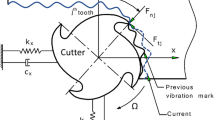Abstract
Dynamic force modeling can quantitatively describe the force with amplitude-frequency characteristic and facilitate understanding of the influence of grinding parameters on dynamic performance. This research attempts to build up dynamic grinding force models through empirical approaches. In the paper, the related parameters in the empirical model are studied based on the fact that the dynamic grinding force is due to the dynamic change of depth of cut and the dynamic model of grinding process developed in previous studies. Then grinding force model is established using the process parameters like wheel speed, feed rate, and dynamic change of depth of cut. At last, the coefficients are determined experimentally and the models are verified at specified conditions. The grinding parameters, the dynamic process of the grinding, and the machine tool conditions are taken into account in the paper. The empirical model developed in this paper can be used to predict the variation of the dynamic grinding force during process. This model can also be used to guide the selection of grinding conditions and to develop the machine tool for dynamic performance optimization.
Similar content being viewed by others
References
Malkin S (1989) Grinding technology: theory and application of machining with abrasives. Horwood, New York
Malkin S, Guo C (2008) Grinding technology: theory and application of machining with abrasives. Industrial, South Norwalk
Durgumahanti USP, Singh V, Rao PV (2010) A new model for grinding force prediction and analysis. Int J Mach Tools Manuf 50:231–240
Brach K, Pai DM, Ratterson E, Shaw MC (1988) Grinding forces and energy. J Eng Ind Trans ASME 110:25–31
Lindsay RP (1971) On the metal removal and wheel removal parameters—surface finish, geometry and thermal damage in precision grinding. Dissertation, Worcester Polytechnic Institute
Malkin S, Cook NH (1971) The wear of grinding wheels: part 1—attritious wear. ASME J Eng Ind 93:1120–1128
Li L, Fu J (1980) A study of grinding force mathematical model. CIRP Ann 29:245–249
Younis M, Sadek MM, Wardani TE (1987) A new approach to development of a grinding force model. ASME J Eng Ind 109:306–313
Dai H, Yuen KM, Elbestawi MA (1993) Parametric modelling and control of the robotic grinding process. Int J Adv Manuf Technol 8(3):182–192
Badger J, Torrance A (2000) A comparison of two models to predict the grinding force from wheel surface topography. Int J Mach Tools Manuf 40:1099–1120
Challen JM, Oxley PLB (1979) An explanation of the different regimes of friction and wear using asperity deformation models. Wear 53(2):229–243
Williams JA, Xie Y (1992) The generation of wear surfaces by the interaction of parallel grooves. Wear 155(2):363–379
Xie Y, Williams JA (1993) The generation of worn surfaces by the repeated interaction of parallel grooves. Wear 162:864–872
Xie Y, Williams JA (1996) The prediction of friction and wear when a soft surface slides against a harder rough surface. Wear 196(1):21–34
Tang J, Du J, Chen Y (2009) Modeling and experimental study of grinding forces in surface grinding. J Mater Process Technol 209(6):2847–2854
Hecker RL, Liang SY, Wu XJ, Xia P, Jin DGW (2007) Grinding force and power modeling based on chip thickness analysis. Int J Adv Manuf Technol 33(5–6):449–459
Wang D, Ge P, Bi W, Jiang J (2014) Grain trajectory and grain workpiece contact analyses for modeling of grinding force and energy partition. Int J Adv Manuf Technol 70(9):2111–2123
Tahvilian AM, Hazel B, Rafieian F, Liu Z, Champliaud H (2015) Force model for impact cutting grinding with a flexible robotic tool holder. Int J Adv Manuf Technol. doi:10.1007/s00170-015-7919-z, 1–15
Agarwal S, Rao PV (2013) Predictive modeling of force and power based on a new analytical undeformed chip thickness model in ceramic grinding. Int J Mach Tools Manuf 65:68–78
Cao J, Wu Y, Li J, Zhang Q (2015) A grinding force model for ultrasonic assisted internal grinding (UAIG) of SiC ceramics. Int J Adv Manuf Technol 81(5):875–885
Feng JP, Chen JN (2013) Prediction of grinding force in microgrinding of ceramic materials by cohesive zone-based finite element method. Int J Adv Manuf Technol 68(5–8):1039–1053
Li H, Shin YC (2006) A time-domain dynamic model for chatter prediction of cylindrical plunge grinding processes. J Manuf Sci Eng 128(2):404–415
Chang HC, Wang JJJ (2008) A stochastic grinding force model considering random grit distribution. Int J Mach Tools Manuf 48(12):1335–1344
Zhang N, Kirpitchenko I, Liu DK (2005) Dynamic model of the grinding process. J Sound Vib 280(1–2):425–432
Leonesio M, Parenti P, Cassinari A, Bianchi G (2014) Force-field instability in surface grinding. Int J Adv Manuf Technol 72(9–12):1347–1360
Park HW, Liang SY (2009) Force modeling of microscale grinding process incorporating thermal effects. Int J Adv Manuf Technol 44(5–6):476–486
Liu Q, Chen X, Wang Y, Gindy N (2008) Empirical modelling of grinding force based on multivariate analysis. J Mater Process Technol 203(1):420–430
Guo M, Li B (2015) A frequency-domain grinding force model based approach to evaluate the dynamic performance of high speed grinding machine tools. Mach Sci Technol. doi:10.1080/10910344.2015.1133915
Author information
Authors and Affiliations
Corresponding author
Rights and permissions
About this article
Cite this article
Guo, M., Li, B., Ding, Z. et al. Empirical modeling of dynamic grinding force based on process analysis. Int J Adv Manuf Technol 86, 3395–3405 (2016). https://doi.org/10.1007/s00170-016-8465-z
Received:
Accepted:
Published:
Issue Date:
DOI: https://doi.org/10.1007/s00170-016-8465-z




